
E-mail: font@focusonnature.com
Phone: Toll-free in USA 1-888-721-3555
or 302/529-1876
 |
PO Box 9021,
Wilmington, DE 19809, USA E-mail: font@focusonnature.com Phone: Toll-free in USA 1-888-721-3555 or 302/529-1876 |
HIGHLIGHTS
FROM some PREVIOUS
FOCUS ON NATURE TOURS
in PANAMA
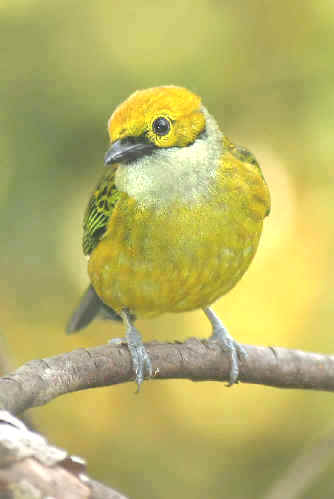
Silver-throated Tanager
The
tour summaries here are with the most-recent tours first.
For some tours there are links below for longer narratives. Also there are links
to UPCOMING TOUR ITINERARIES, and lists (some with photos) of BIRDS, MAMMALS,
and OTHER NATURE.
Some
Previous
Tours:
July 2013 (Central & Eastern Panama)
February 2006 (Central & Eastern Panama)
February 2006 (Western Panama & Southern Costa Rica)
March
2004 October-November
2002 August
2002 March
2002
In all, there have been 10 FONT birding & nature tours
in Panama
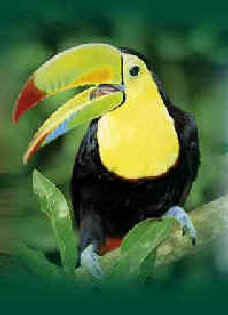
Keel-billed Toucan
Links:
Upcoming
FONT Birding & Nature Tours in Panama
A
List of Panama Birds
A List & Photo Gallery of Central American Birds, in 4 Parts:
Part #1: Tinamous to Doves Part #2: Macaws to Woodpeckers
Part #3: Manakins to Thrushes Part #4: Thrushes to Buntings
Central American Mammals (with some photos)
Amphibians & Reptiles of Panama & Costa Rica (with some photos)
Central American Butterflies & Moths, A List in 6 Parts (with some photos)
![]()
PANAMA (central & eastern) - July 2013
Panama
is a small country. 40 of the US states are larger than it. 10 US states
are smaller. The closest US state in size to Panama is South Carolina, which is
slightly larger.
In size, Panama has only 77,381 square kilometers, or 29,762 square
miles.
But even though Panama is small, it
has a big bird list, in fact one of the highest lists of lists of birds
of any country in the world, and certainly so for its size.
Nearly a thousand different bird species have been known to occur in Panama.
975 species are included in the Panama bird-list in the FONT website (link to
it below).
Actually
the "official list" for the country is even slightly higher than that, with 978 species
as of 2010.
In all of North America, north of Mexico, and even including vagrants, not
nearly that number of species have been found.
During FONT birding & nature tours in Panama
over the years, nearly 600 species of birds have been tallied.
During our one week-long FONT Panama Tour in July 2013,
over 220 bird species were found. That's over 20 per cent of the total species
in the Panama bird-list.
And when it is taken into account that a good chunk of Panamanian birds are only
in western Panama (where we were not), and that a substantial number of
vagrants have occurred in the country, and that about 150 Panamanian species are
seasonal migrants from North America (not there when we were in July),
our number of birds was quite good
indeed.
Many of the birds that we found during that tour were in one region,
the Canal Basin, with, in that area, some
prime birding places such as the Pipeline Road, Gamboa,
and the Metropolitan Park in Panama City.
Birds for us included an assortments in Neotropical groups of parrots
and parakeets, trogons and toucans, motmots and manakins,
wrens, and antbirds.
Even though, as noted, the number of birds in Panama is great, the
number of ants that country is far, far greater, and so we
watched again, as we have in Panama in the past, frenzies of feeding birds
following the masses of ants and other creatures escaping from them. The avian
ant-followers included antbirds of course, and also woodcreepers
and tanagers.
Also during the July 2013 tour, we ventured further
east in Panama, as far the lowlands in the remote and wild Darien
province.
Doing so, we saw a number of birds either restricted to eastern Panama and
Colombia, or birds more "South American" than "Central
American".
In those categories were species such as White-eared Conebill, Black
Oropendola, Green Manakin, Double-banded Graytail, Slate-throated
Gnatcatcher, Spot-breasted Woodpecker, Spectacled Parrotlet, and Orange-crowned
Oriole.
At a very pleasant place, with good accommodations and meals, where we stayed near
the Darien border, we saw not only the just-mentioned Spot-breasted
Woodpecker (a very local bird in Panama) and Spectacled Parrotlet,
but also a nice assortment of hummingbirds.
Mammals during our July 2013 Panama Tour
included: two species of sloths, Kinkajou, Capybara, Coati, Agouti,
Paca, Neotropical River Otter, Crab-eating Raccoon, and every day Howler
Monkeys either seen or heard.
Butterflies were numerous. Among them were Morphos, some bright
blue and others paler, nearly white, along with many other butterflies such as Malachites
and various Longwings and Swallowtails, just to mention a few.
So, during our summertime week in Panama we saw much, and, as we did so, we had a
good time!
Links:
More about the FONT tour in central & eastern Panama in July 2013
A List of Birds & Other Wildlife during our Panama Tour - July 2013
![]()
PANAMA (Central
& Eastern) - February 2006
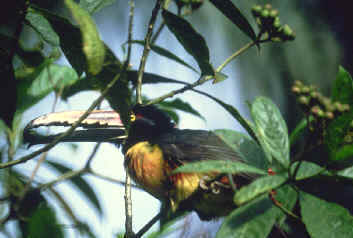
Collared Aracari
During the
FONT February 2006 Tour in Panama, we traveled
from the Canal Basin and east into the lowlands and foothills of
Darien
province.
The further east we went, the "wilder" Panama got, in that
the Pan American highway dead-ends, the population dwindles, and that the
habitats for birds, and the numbers of birds, increase.
Among the birds were
some more common in South America than in Central America.
Birds in that
category that we saw included: Capped and Cocoi Herons, Pearl Kite,
Red-throated Caracara, Red-and-green Macaw, Golden-green Woodpecker,
One-colored Becard, Pied Water-Tyrant, Green-and-Rufous Kingfisher, and Orange-crowned
Oriole.
Other interesting birds, among the 200 or so species we saw in less
than a week, included some that are restricted to only eastern Panama and
adjacent Colombia.
Among those birds were: Double-banded Graytail, Black
Antshrike, White-headed Wren, Black Oropendola, and the White-eared
Conebill (a favorite!).
A boat-ride along a river in the Darien
foothills produced, in addition to the Red-throated Caracara and Green-and-rufous
Kingfisher, some other good ones including Agami Heron, American Pygmy
Kingfisher, and some wonderful looks at Crane Hawks.
A rarity for
Panama was a Long-billed Curlew (and unusual for this tour as it's a
bird mostly of North America!)
Links:
More about the FONT tour in central & eastern Panama in February 2006
List of Birds during our Panama Tours - February 2006
![]()
PANAMA
(western) & COSTA RICA (southern) -
February 2006
During this
tour, in the highlands and on the Pacific side of southern Costa Rica
and in
the adjacent Chiriqui province of Panama, 267 species of birds were observed.
238 of them were found in Costa Rica.
107 were found in Panama during only 2 days in that country.
78 of the 267 species were found in both countries, while 29 species were found
in Panama alone. In the last category were: the Veragua Parakeet (an
isolated population that has been considered a subspecies of the Brown-throated
Parakeet of northern South America), the Veraguan Mango (which
was considered part of the Green-breasted Mango; we saw a female
on a nest), and the White-throated Mountain-gem (closely related
to other mountain-gems, particularly the Gray-tailed
Mountain-gem that we also saw - in Costa Rica).
This was the 27th FONT birding tour in Costa Rica. Prior to it, our cumulative
total of birds for CR was 684. During this tour, 1 new species was added to that
CR list, the Southern Lapwing. 2 of them were seen in a pasture south of
Golfito; they appeared to be on territory.
Other notable birds found during the southern Costa Rica portion of this tour
included: Masked Duck, Barred Hawk, Sunbittern, Scarlet Macaw, Baird's
Trogon, Chiriqui Yellowthroat (has been considered part what has been the
Masked Yellowthroat of South America), Zeladonia,
Black-cheeked Ant-Tanager, Red-breasted Blackbird, Volcano Junco.
Also, in all there were a number (22 species) of hummingbirds, and
some notable Finches: the Peg-footed, the Large-footed, and
the Yellow-thighed.
Nature other than birds included some mammals (notably Mantled
Howler & White-faced Capuchin Monkeys, and a Kinkajou
in the daytime - in the photo below), and Morelet's Crocodile,
Spectacled Caiman, Green Iguana, and an assortment of butterflies.
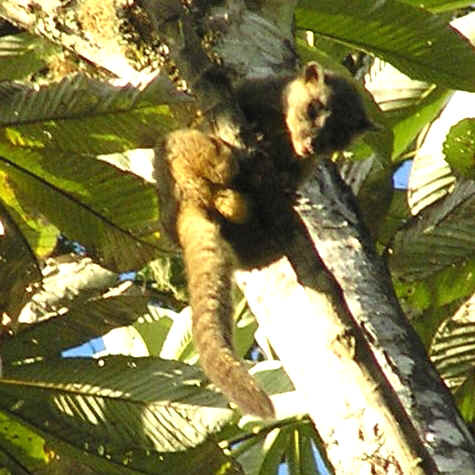
A Kinkajou photographed in
the forested mountains of southern Costa Rica
during the FONT tour in February 2006.
(Photo by Rosemary
Lloyd)
Links:
More about the FONT tour in southern Costa Rica & western Panama in February 2006
List
of Birds during our Costa Rica & Panama Tours - February '06
![]()
"Panamanian
Birds: Some Greater, Some Lesser, One Resplendent"
The following account written by Armas Hill, leader of
the tour.
Panama may
well be considered a "lesser" country in terms of size, but certainly
it's a "greater" one in relation to birds. In it, over 900 species
have been recorded. A few of them have been so labeled (in their English names)
as "lesser" or "greater". Comments about some of these
birds, as well as others, will follow in this narrative about our March
22-30, 2004 FONT birding tour in Panama.
But, first, a few words about the small and birdy Central American country, Panama, that's well known for the famous canal that connects the Caribbean and the Pacific. The country, on an isthmus, is actually a connection itself, a "land bridge", between the continents of North and South America. (In this regard, Central America is considered as a portion of the North American continent.)
A long time ago, where eastern Panama is today, there was a sea, and the continents were not joined. Today, in eastern Panama, by the border with Colombia (of which Panama used to be a part), the avifauna is notably South American, with macaws, hummingbirds, antbirds, furnariids, tapaculos, and tanagers representative of that continent.
One species, that's common throughout South America, and reaches its northern limit in the Americas in Panama, is the Southern Lapwing. Vagrants have recently been noted further north in northern Costa Rica and even Belize, but the Panama canal basin is the norm. During our March '04 tour, we saw a pair of Southern Lapwings, well beyond the canal area, at a small pond in the Chiriqui province, actually not all that far from the Costa Rican border. It may only be a matter of time before the species is routinely found further north yet. The bird may well be spreading as deforestation has occurred. By the way, it's odd how throughout the world Lapwings (of whatever species) are only absent on one continent - North America.
There are many birds that breed in North America during the summer and either spend the rest of the year in Panama, in various habitats, or migrate through it (twice, south in the fall & north in spring) across the narrow "land bridge". There were, for example, flocks of Broad-winged Hawks that were seen going north during our March '04 tour, circling in the sky above the Chiriqui highlands. These raptors, in the thousands, would soon be throughout the North American continent. In trees below the hawks, warblers such as Golden-winged and Blackburnian would soon be going, while other birds that were with them in March, such as colorful tanagers and euphonias, would stay.
Our March 2004 Panama birding tour was in two regions of the country the Chiriqui province (just referred to) in western Panama. (Yes, the country of Panama is more east-west than north-south), and the canal basin in central Panama (where the canal is more north-south than east-west).
In the canal basin, one afternoon, as many as 50 Eastern Kingbirds were roosting in the upper branches of a couple bare trees. They were enroute from where they "wintered" in South America to where they'll "summer" in North America, during their journey across the "land bridge" known as Panama. Also obvious during their migrations, were many Turkey Vultures in a "stream" overhead in the sky going north over the canal, and Barn Swallows in big numbers, likewise heading north, along the Pacific coast.
Those Eastern Kingbirds, just noted by the Panama Canal, that would leave, were in the same vicinity as Tropical Kingbirds and other flycatchers, and other tropical birds such as aracaris, toucans, and trogons, that would stay. Baltimore Orioles there would go. Yellow-tailed Orioles would remain.
In relation to another migration of birds having arrived from South America into Panama to breed, some in that category were there, such as Yellow-green Vireos nest-building, and Piratic Flycatchers constantly calling.
And so it was that there were birds of various sorts, from or going to various places, as we birded about in the canal basin. During our walks during one day, we saw about 115 species, as we were only on foot, never that day in a vehicle.
Some of the birds were nice to see, bright and colorful, ranging from the big toucans to the small Red-legged Honeycreepers and Golden-collared Manakins. The latter, seen at a few places, performing at their leks, were absolutely tremendous to watch! Some birds were nice to hear, such as the Song Wren and the Clay-colored Thrush, the latter with its varied repertoire.
An aside, regarding the Red-legged Honeycreeper: It's truly attractive (a bright purplish blue, with a turquoise crown and those very red legs), and the bird "must know it". In a residential area, one was on a mirror of a car in a driveway, simply staring at its reflection in the window. A British couple, who recently moved to Panama, asked us what the "beautiful bird" was on their car!
As noted a bit ago, some of the birds during our tour were big, while some were small. And that leads us to the birds so dubbed "greater" and "lesser".
One of the "Greaters" that we saw was the Ani. It's nearly 20 inches long, with a glossy bluish sheen and yellow eyes. The Greater Ani notwithstanding, there is no "Lesser Ani", but nearby there were the more-common Smooth-billed Anis, just over 12 inches long, and black (even their eyes).
By the edge of a nearby lake, we watched some Lesser Kiskadees flying about, close to us along the shore, catching insects. Even with the name "lesser", they're actually rather nice flycatchers, yellow-bellied with long slender bills. Yes, there is a more well-known Great Kiskadee, a larger, similar-looking bird, that's widespread from southern Texas south to Argentina. Actually, there are a number of such yellow-bellied flycatchers that are look-alikes to the Kiskadees. (The widespread Social Flycatcher could well be a "lesser kiskadee".) But, again, when looking at the tame flycatchers by us along the lake shore, one can think, that no matter what, the bird will be known as "lesser". (In Spanish also, it's Bienteveo Menor, meaing "lesser". The Great Kiskadee is Bienteveo Grande.)
Now, really, with the Yellowlegs, "Greater" and "Lesser" makes some sense. Greaters usually appear larger, and Lessers usually smaller. And there are both the Greater and the Lesser.
Yellowlegs were among the thousands of
shorebirds in an area of coastal mudflats in Panama City. Most were Semipalmated
and Western Sandpipers, but there were also hundreds and hundreds of Whimbrels
and Willets, and Black-bellied and Semipalmated Plovers,
Spotted Sandpipers and dowitchers, along with numerous pelicans,
egrets, herons, cormorants, gulls, terns, frigatebirds, Osprey, and Peregrine
Falcon.
The falcon, of course, was drawn into the scenario by the thousands of
shorebirds.
Nice to see among the shorebirds was another species of the tribe, the Red
Knot. It could be known as the "Lesser Knot" as the only other
knot in the world is the Great Knot (of Asia). But the "Lesser Knot"
it's not. (In various places in the world, however, particularly Europe, it is
simply "Knot".)
A bird that is "Lesser", and
probably as much as one could be is a Greenlet. (At least, it's not a
"Least" - reference to a couple of them will follow.)
But those Lesser Greenlets that we saw in Panama really were, even though
there is no such thing as a "Greater Greenlet" (if you could imagine
such a thing!).
The suffix "let" in greenlet (a small vireo) already connotes the
diminutive. Greenlets are dull, with not much to them in terms of color or
features. So, simply put, how much "lesser" can a bird be? And, lesser
than what?
Shortly before we left Panama, as we
awaited a flight, late in the day, from a small, remote airport, some Lesser
Nighthawks were foraging. We saw them well, flying not just high in the sky
but nearby close to the ground. But, again, there's no "Greater
Nighthawk".
Although, the following evening in Panama City, the local race of the Common
Nighthawk was seen, flying about and calling above the city's buildings.
That species had just arrived from where it winters somewhere in South America.
The scientific name for that subspecies is "Chordeiles minor panamensis".
The "panamensis" part is all right, but the nomenclature with
"minor" seems a bit confused, as one could say it could be better with
the Lesser Nighthawk. After all, "Lesser" than "minor" must
not be much.
Lesser yet must be the birds named
"Least". On a small pond, near the Chiriqui Pacific coast, we saw a
family of Least Grebes, with the two small adults accompanied by even
smaller young, the "least of the least" you might say.
Among the many shorebirds in the area of Panama City the last day, was the last
new bird recorded during our tour, the Least Sandpiper, last and least.
The smallest bird of our tour did not have the names "least", "lesser", or "minor". It was a Hummingbird called Scintillant, and only 2 and three-quarters inches long. A normal writing of the bird's name is just about as long as the bird. We enjoyed watching some Scintillant Hummingbirds feeding on flowers in the Chiriqui hills. We actually saw quite a number of hummingbirds in that area. Nice among them was a perched Violet Sabrewing at the edge of a coffee plantation. It's a big one, nearly 6 inches long. If there were to be "lesser" and "greater" hummingbirds, the Scintillant and the Sabrewing, respectively, would qualify.
In the jungle of the canal basin, there's a bird that used to be called the Brownish Flycatcher (not much of a name), now called the Brownish Twistwing (much better). It has the habit of frequently lifting its wings above its body, one at a time. In the trees of that same forest, there we also saw a smaller flycatcher, the Yellow-green Tyrannulet, which also has a habit of flicking its wings straight up over its back, one at a time. I couldn't help but refer to these two as the "greater" and "lesser" "wing-flickers".
But the greatest bird sighting for most of us on the tour was in another type of Panamanian forest, in the mountains. It was of a bird in an "enchanted" forest of tall trees with bromeliads, mosses, and ferns. In a beautiful place, the bird more than beautiful, was in fact the Resplendent Quetzal. We saw it perched, irridescently plumed and crested, emerald and scarlet. Its name, "quetzal" meant "precious plume" in the language of the native people known as the Nahuatl.
As we beheld the Quetzal, we heard, in
that gorgeous forest, the flute-like notes of Black-faced Solitaires, and
the lovely song (rather like that of Hermit Thrush) of the Orange-billed
Nightingale-Thrush. In the background, there was the boisterous bong of the
Bellbird. We were fortunate to a have a wonderful view of that Three-wattled
Bellbird.
One of our tour participants told me, as we viewed it, that it was one
of her "target birds". The previous evening, at dinner, she had told
of how where she lives in far-northern Vermont, with her rifle she shoots above
the heads of bears to keep them from her porch. So, when she later said
"target", the word had meaning to me.
As we watched the Bellbird, the sun shone through the trees on its chestnut-rufous
body and white head. As it called, its three worm-like wattles shook.
Getting to that forest with the Quetzal and Bellbird was, to put it aptly, an adventure. On a very bad (virtually impassable) dirt road, we rode in a large 4-wheel drive truck. And then we walked. But It was all well worth it. Some of the other wonderful birds for us, that day in the Chiriqui highlands, included Collared Redstart, Prong-billed Barbets, and Spangled-cheeked Tanager.
Another day, in the Chiriqui lowlands,
near the Pacific, was good as well. As we approached the ocean, along a small
road by a cultivated field, suddenly the late-morning clear sky was filled with
birds. Above a large machine moving on the dirt of the field there were
apparently many insects, as in flight there were hundreds of Barn Swallows,
dozens of Swainson's Hawks, while circling and floating above, for good
measure, there were numerous Wood Storks and Turkey Vultures. The
Swainson's Hawks were mostly the light-morph, but some were dark. Some landed on
the field. Most were in the sky. With them, was one Peregrine Falcon
flying about. Most Swainson's Hawks winter in southern South America, in
Argentina, but some stay during that season in Panama. Our birds, on and over
the field, were apparently Panamanian winterers.
By the way, that large machine moving on the dirt, I was told, by one of our
tour participants, Rita, who grew up in North Dakota, was a combine. Not a
tractor, not a plow, but a combine as someone from the Dakotas would know.
The area of the field, just referred to, was dry. More dry, we were told, than usual in the area. In a ditch, not far away, there were more Wood Storks along with swarms of concentrated egrets (and tiger-herons), Purple Gallinules, and Northern Jacanas. There were, together, at least 50 each of the gallinules and jacanas. As we watched them, in the wet ditch, all of a sudden there was commotion. An animal, a Tayra, a large weasel, entered the scene, and birds scattered in all directions. When the animal saw us, it also made a quick exit.
The Tayra was just one of the animals
seen during our tour. As we walked in a tropical forest of the canal basin, we
encountered a family of Collared Peccaries.
Elsewhere we saw troops of Mantled
Howler Monkeys and a few Geoffrey's Tamarins. Agoutis were
easy to see. As was a Three-toed Sloth. It certainly didn't run away.
When we were along the waterfront of Panama City, at Viejo Panama (or "Old Panama"), with its historic stone structures, after watching thousands of birds, as the day ended, there were streams of small fast-flying bats in the evening sky.
The last evening of the tour was really
one "for the sky". On the roof of the hotel in Panama City, there was
quite a nice observation area above the city. Those Common Nighthawks,
already referred to, (C.m. panamensis) flew and called. Bats of various sorts
zipped about.
In the clear sky above, there were, in a row, 5 planets. All of them were seen
in a telescope. Starting from the west, in the twlight sky, there was Mercury.
Above it, and very, very bright, was Venus. Then, there was the red
planet of Mars. (Not as bright as it was the previous year, but still
bright enough). Then, there was Saturn. Its rings were angled nicely to
be seen well in the scope. And lastly, there was Jupiter, quite bright.
In the telescope, its visible moons shone well. Such a lining of five planets,
nicely in view in the evening sky, is unusual. It won't happen again, like that,
until 2036.
But we'll certainly be going to Panama
again, to partake in the wonderful bird-life and other nature, before that.
Whenever we go to Panama, it's a great place to be.
A complete list of the 516 species of birds that have been cumulatively found during FONT tours in central & western Panama elsewhere in this web-site.
Links:
List of Birds & Other Wildlife during FONT Panama Tours - March & August 2004
![]()
PANAMA - October/November 2002
The following account written by Armas Hill, leader of
the tour.
This was our third FONT
birding tour in Panama this year. The others were in March and August. In March,
we visited the Chiriqui Highlands and the Lowlands of the Canal Basin. In
August, we were only in the Canal Basin. We spent a fine day in the rainforest
on the Island of Barro Colorado. In the Gatun Lake, created when the Panama
Canal was made. Later, the island was the subject of a book written in 1929, by
the ornithologist, Frank Chapman, entitled "The Tropical Air Castle".
To this day, it's a most interesting place to visit. And, we did so, again,
during our October-November Panama tour, again only in the Canal
Basin.
Once again, on Barro Colorado, we enjoyed some fine encounters with antbirds, and other birds, attracted to an ant swarm. No matter how often we see the dapper, little Spotted Antbird, it's a fine sight, particularly when it and other antbirds and woodcreepers were so close to us, only concerned about the ants.
Barro Colorado Island is also a
good place to see mammals. Ocelots and pumas, there, we did not see (not
surprisingly), but we did have fine looks at 3 species of monkeys (including
the nicely-patterned Geoffrey's Tamarin), numerous coatis and agoutis,
and even a White-tailed Deer, running away from us in the forest.
Some aspects of the bird-life during our October-November Panama Tour were
rather different than those earlier in the year. One, particularly so, was a
large, dramatic overhead migration of Turkey Vultures one morning.
Thousands and thousands flew over us, kettle after kettle, and in line after
line. 300 were tallied going past a certain point during a minute, and the same
pace continued for 3 to 4 hours. There were an estimated 80 to 100 thousand Turkey
Vultures journeying south, from central and western North America to South
America. Among them there was a smathering of Swainson's Hawks, and a few
Broad-winged Hawks.
Among the smaller landbirds we found in Panama, in late October and early
November, having migrated from North America, notably evident were Eastern
Wood-Pewees. Their calls, throughout the tour, reminded us of their being
about.
Near the Caribbean Coast, we found Prothonotary
Warblers very numerous. In mangroves and nearby forests, we saw, at least, a
few hundred of them. Ten or so, at one time was not unusual. One one occasion,
as many as 7 were in a binocular-field at once.
Among the neotropical resident
birds we found to be particularly numerous were Collared Aracaris (with
many seen each day) and Purple-throated Fruitcrows in feeding flocks.
Also, toucans (Keel-billed and Chestnut-mandibled) were
enjoyed, as were Yellow-backed Orioles and Red-breasted Blackbirds.
We had some close looks at trogons, motmots, and puffbirds
(including Black-breasted and White-whiskered), and Spot-crowned
Barbets.
During our previous tour in August, no Chestnut-headed Oropendolas or Yellow-rumped
Caciques were to be seen. But, in October-November, both species were
conspicuous. One day, late in the afternoon, we saw a flock of at least a couple
hundred Yellow-rumped Caciques going to roost. That species, by the way,
has been "split" now into 2, with the Western Yellow-rumped Cacique
being the bird in Panama.
Probably the "favorite
bird" of our tour was a tame, and beautiful, adult Semiplumbeous Hawk,
sitting on a tree-limb close to us, along a forest road. With its white breast
and bright orange bill, yes, the bird is a beauty. As we watched it, the yellow
eyes of the hawk were watching us.
During our last morning of the tour, it was a mammal, not a bird, that
put on the "final show". A Two-toed Sloth was seen close to us,
in a tree. It was a mother hanging on the tree, with a young hanging on her.
Often sloths don't move much, but this one, as maybe because we were so close,
moved down and then back up the tree. Then, we had to move, ourselves, to the
airport, for home.
In all, a fine tour, with lots of birds, and again some wonderful experiences in Panama.
![]()
PANAMA - August 2002: A tour with twistwings & softwings
The following account written by Armas Hill, leader of the tour.
Our tour in Panama, in the
summer of '02, was designed as a "get-away", with as much fine
tropical birding as possible, for those without much time. Just shy of a week,
the tour was scheduled when teachers and those who otherwise might not have been
able to, could go. It was the plan to have a tour without much travel at the
destination, but yet with a large number of birds. And that's what happened.
About 200 species were found in just one area in the former Canal
Zone. Some were as bright as the Blue Cotinga and the Green
Shrike-Vireo. Some were as gaudy as the toucans. Others were as
colorful as trogons and tanagers. Conversely, some "just
blended in" with their backgrounds, such as the Broad-billed Sapayoa,
while others, such as the male Red-capped Manakin, were like a beacon one
moment, to be gone the next.
What virtually all of the birds we saw had in common was that they were
"tropical". In mid-August, there were only very few migrants: a Spotted
Sandpiper or two, and a couple Orchard Orioles.
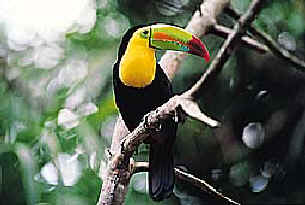
Keel-billed Toucan,
one of the most tropical of birds during
our August 2002 Panamanian Tour.
One of the highlights of the
tour was the visit to Barro Colorado Island,
with its wonderful neotropical forest. Now in the middle of a large lake, the
former hilltop became an island when the Panama Canal was made. The island has
been under the auspices of the Smithsonian Institution for years. Walking there,
in the forest, and around the research facilities, one's mind can drift back
through ornithological history. In the "Tropical Air Castle", names
are remembered of those who studied birds there years ago, Frank Chapman and
Alexander Wetmore.
But one's mind can't drift very long when in that forest. There's too much to
experience. There's too much to see, and to hear. One must be continually
looking and listening. And then wonderful things are seen.
That's what happened for us when we came upon a swarm of ants that was on the
ground, in the leaf litter, and on nearby roots and limbs. It was a swarm with a
tremendous accompaniment of birds. We stood ever so still (but smartly not atop
the ants!) The dapper Spotted Antbirds on twigs just a few feet from us
were so involved with the ants as to be oblivious to us. As were the Bicolored
Antbirds and Western Slaty-Antshrikes. Not only antbirds, but
also woodcreepers and flycatchers were attracted to the
insectivorous gathering.
Some White-whiskered
Puffbirds were also drawn to the fray. They perch ever so still, that is
when they're not feeding on insects. Another name for the brown, streaked bird
is the White-whiskered Softwing. It's a nice name. One can remember a
nice essay by Alexander Skutch about the bird.
Another bird that's brown, in the forest with us at Barro Colorado was a bird
that's been called the Brownish Flycatcher. It doesn't sound like much,
but a "new" name for the bird that's more intriguing is the Brownish
Twistwing. During a walk along one trail at Barro Colorado we were treated
to both twistwings and softwings.
Along another portion of trail, we stood still again, to watch a Great
Tinamou, itself still, on the ground, before it walked slowly away.
Elsewhere, on a limb above us a Crested Guan eyed us as we eyed it.
But certainly among our best Panamanian forest experiences, during the tour,
were those with the Song Wren. We had some nice encounters with the bird,
seeing it well a few times. The species is normally a skulker, more readily
heard than seen. At one particular place and time, we were lucky to see 4 Song
Wrens in front of us at once, walking slowly about on the ground, and then up
onto on arching twigs. And then one of Song Wrens even sang. It was one
of the thrills of the tour. The sound is beautiful. The bird, when seen,
resembles one or two of the antbirds, with rufous and brown coloration, and a
blue ring around the eye. Its bill appears longer than its tail. It may not be.
But the tail is short.
Seeing the birds referred to here (and others) in that "Tropical Air
Castle", the neotropical forest, enabled us to take home, even after a
relatively short visit, some wonderful memories.
Not only birds did we see during our week or so in Panama. We also saw a number
of animals: capuchins and howler monkeys, tamarins, tamanduas,
a tayra, sloths, capybaras, coatimundis, agoutis, raccoon, armadillo,
opossum, squirrels, and bats. Along with huge numbers of leaf-cutting
ants, beautiful butterflies, frogs, and even a snake or two.
Not bad for just shy of a week. See our list of
birds we've found in Panama.
The following came by
e-mail to FONT from an August 2002 Panama tour participant after the tour:
From Ann Shadwick, of Pacifica, California, USA:
Thanks so much for a wonderful
tour!
![]()
The following account written by Armas Hill, leader of the tour.
The Resplendent Quetzal was among the birds enjoyed during our just-completed FONT birding tour in Panama. Voted the "top bird" by the participants following the tour, it was the bird most enjoyed.
Said by many to be about the most
beautiful of birds, the quetzal was seen (and heard) in a forest that's
beautiful itself, in the Chiriqui highlands of western Panama. Mostly a
glittering bright green, but with a golden hue, and a bright red belly, the bird
is about 15 inches in length.
Add to it another 15 to 30 inches of plumes, on the male - an extraordinary
train of long bright green feathers. Those feathers were hanging, like a palm
frond, out of a treehole in which there was a nest. We watched as the quetzal
turned around, so that its head protruded from the hole. It then left the
cavity, and perched (facing us) on a nearby horizontal branch. The most
beautiful of birds was in clear view.
As we walked away along the forest trail, more than one quetzal could be heard
calling. They flew about, in the canopy, from tree to tree. Before we left we
had good looks at 7 of the spectacular birds.
The quetzal was only one of a number of
fine birds we encountered that day in the Panamanian highlands. Others included
a calling Three-wattled Bellbird in a treetop, just above us. Its long
wattles were blowing in the gentle breeze as it gave its far-reaching call.
Closer to the ground, there were the flute-like notes of the Black-faced
Solitaire.
Around us, dapper Slate-throated Redstarts (or more appropriately Whitestarts)
flitted about. Also colorful were Blue-hooded Euphonias (particularly
numerous) and tanagers such as the Flame-colored, Silver-throated,
and Bay-headed.
Small, but nice, were Yellow-bellied Siskins tamely by us.
Also in the realm of small birds were the hummingbirds that ranged from
the shiny Green Violetear and the Snowy-bellied, to the tiny Scintillant,
the latter just over 2 inches long, sometimes floating in the air in the forest.
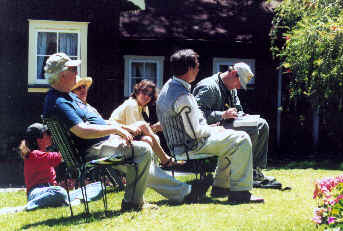
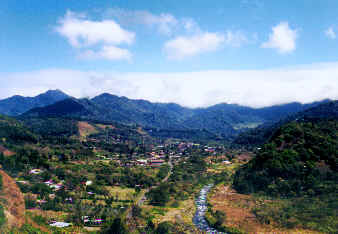
Later in the day, along a rushing stream, there were Sunbittern, Dipper, and Torrent Tyrannulets. The last of these we observed during the final moments of daylight as a pair tucked in to spend the night in a cluster of foliage hanging above the water.
As the tyrannulets' day ended, so did our series of fine encounters with birds of the Panamanian highlands. Or nearly so. A Tropical Screech-Owl called in a tree outside our windows after dark.
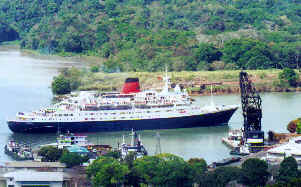
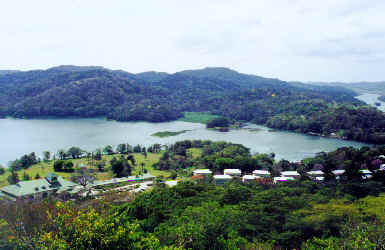
Views from the tower a
Gamboa. The Panama Canal (left) and the
Gamboa Lodge
(right). (Photos by Marie Z. Gardner, during FONT tour - ©
all rights reserved)
Wonderful birding in Panama continued when we went to the lowlands in the basin of the Panama Canal.
We went to the Canopy Tower, from which we saw Blue Cotinga and Green Shrike-Vireo. Along the Pipeline Road, we met upon another Sunbittern. We had a Three-Motmot Morning and a number of looks at trogons and other birds of the tropical forest.
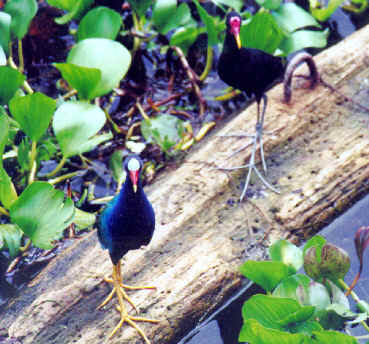
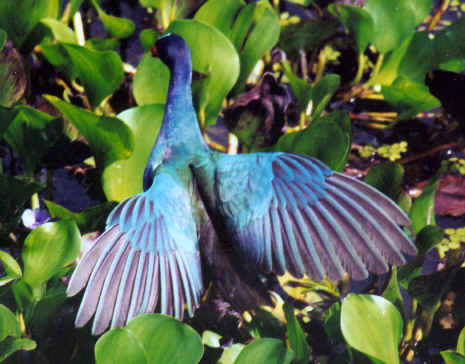
At Gamboa, as we lunched in an outside restaurant by the edge of a lake, there were both Green and Striated Herons, together with Purple Gallinules and Wattled Jacanas. Nearby, there was a conspicuous pair of Southern Lapwings and vocal White-throated Crakes. After dark, along the shoreline, there was the Gray (formerly called the Common) Potoo.
Not too far way, in an area of dry forest, we were with Lance-tailed Manakins and Rosy Thrush-Tanager. A Song Wren sang its beautiful long song. In the late-morning we came upon a Rufous Nightjar, that stayed, ever so still, on the ground, nearly at our feet.
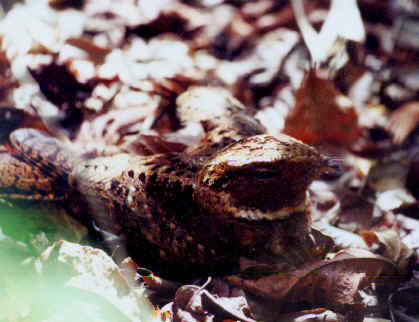
As good as it was to be eye-to-eye with birds in the canopy, such as the Green Shrike-Vireo, and Scarlet Tanagers and Philadelphia Vireos on their way north, it was on the ground where he had some of our best finds, particularly where there were ants - marching ants, on the soil, leaves, branches, vines, and twigs. These ants were accompanied by birds. As we stood still, we watched a number of Bicolored Antbirds, Spotted Antbird, Dusky Antbird, Ocellated Antbird, Gray-headed Tanagers (mostly yellow), Plain-brown Woodcreeper (yes, mostly brown), and even a Blue-crowned Motmot on the ground. As the ants stayed, so did the birds. A Black-faced Antthrush walked through the foray. Nearby, a Spectacled Antpitta was seen on the ground, and Pygmy Antwren and White-flanked Antwren were in the tangles.
With another ant swarm, at a place with dense brush, there were again a number of the antbirds, just-mentioned, but with them the seemingly "huge" and glossy iridescent-blue Greater Ani, also drawn to the ants, and making an assortment of strange sounds long hisses sounding like something electronic or, as it has been written, like a boiler.
So it was that during our week in Panama, we had some wonderfully good experiences with birds.
The "Top Birds" as voted by participants after the tour were:
1 - Resplendent Quetzal
2 - Three-wattled Bellbird
3 - Slaty-tailed Trogon
4 - Blue Cotinga
5 - Ocellated Antbird
6 - Keel-billed Toucan
7 - Lance-tailed Manakin
8 - Blue-hooded Euphonia
9 - Bay-headed Tanager
10 - Fasciated Antshrike
Additionally, 37 other species of birds
received votes.
Link:
List
of Birds & Other Wildlife during the FONT Panama Tour in March 2002